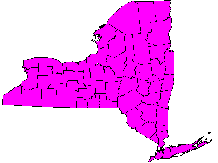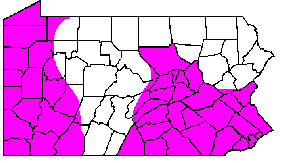Northern Brown Snake
Storeria d. dekayi
Chemung County, NY
Identification- 7-12" (18-30.5 cm) A small light to dark brown
snake. There is a lighter stripe down the back, bordered by two parallel
rows of dark spots. There is a dark streak running down the side of the
head. Belly slightly lighter than dorsum, may be brown gray, or with a
pink cast. Young are darker than the adults, with a light collar. The black
spotting may not be visible. Scales keeled, anal plate divided.
Similar Species- Redbelly snake lacks black
spotting, usually has a bright red, orange, or pink belly. Small Garter
Snakes usually have 3 light stripes and a single anal plate. Young Ringneck
Snakes have smooth scales and bright yellow belly.
Range- All of New York. In Pennsylvania the Northern Brown Snake
is found in the western third of the state and the southeast quarter of
the state. It is apparently absent in the northern part of the state.
 |
 |
Habitat- Varied. Found in suburban areas, grasslands, open woodlands, and margins of swamps, ponds, streams.
Reproduction- Mates spring and fall. Live-bearing, the Northern Brown Snake gives birth July to September to 5-23 (avg 15) young. The young measure 3.5-4.5" (9-11.5 cm) long.
Northern Brown Snake
Storeria d. dekayi
Chemung County, NY
General Characteristics-
Secretive. The Northern Brown Snake is usually seen under boards and
logs relatively close to water. Like many snakes they are diurnal, but
become nocturnal as the summer heat progresses. Some people still refer
to them as "Dekay's Snake." This name honors James E. Dekay, the
prominent 19th century New York naturalist who first described the species.
They are quite common in suitable habitats and are one of a few reptile
species still found in downtown Manhattan (Central Park anyway.)
They do well in captivity and make good pets. Their preferred foods are
earthworms and slugs.
[HOME]